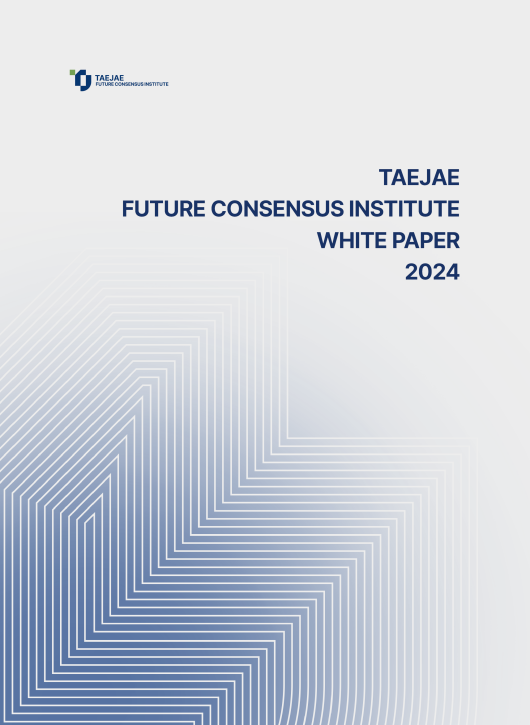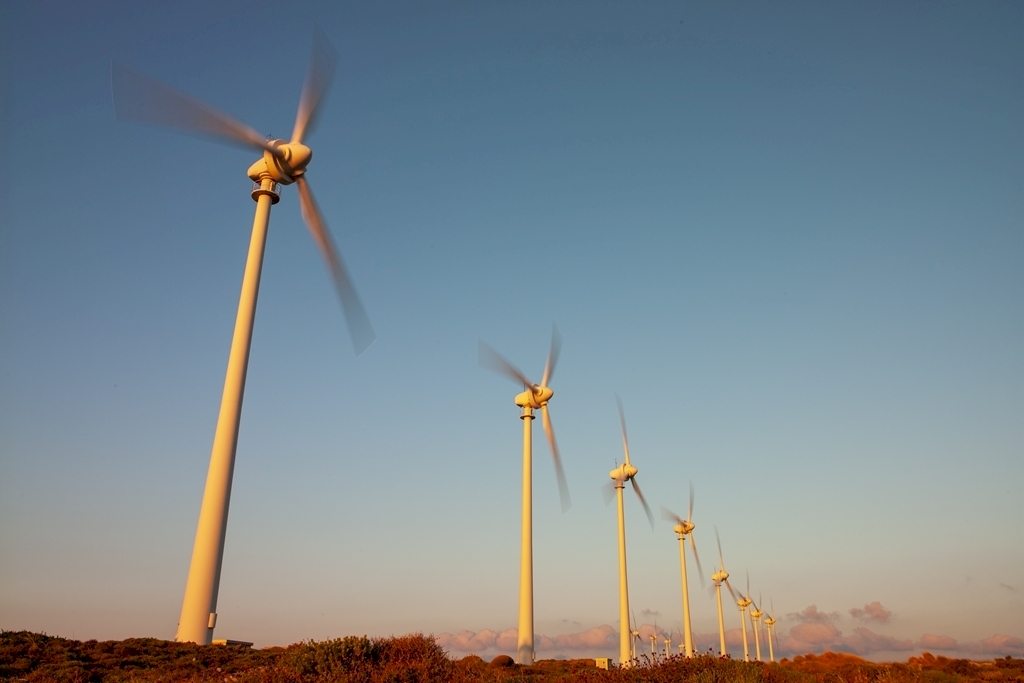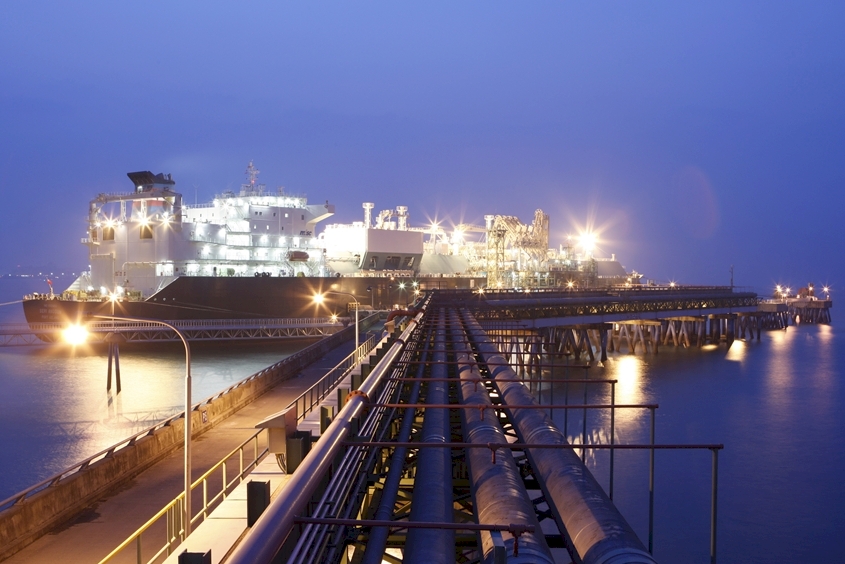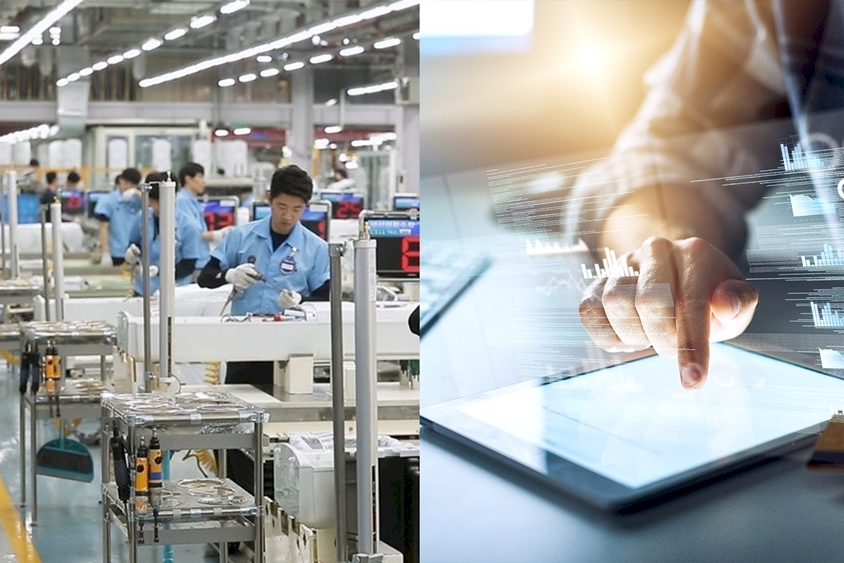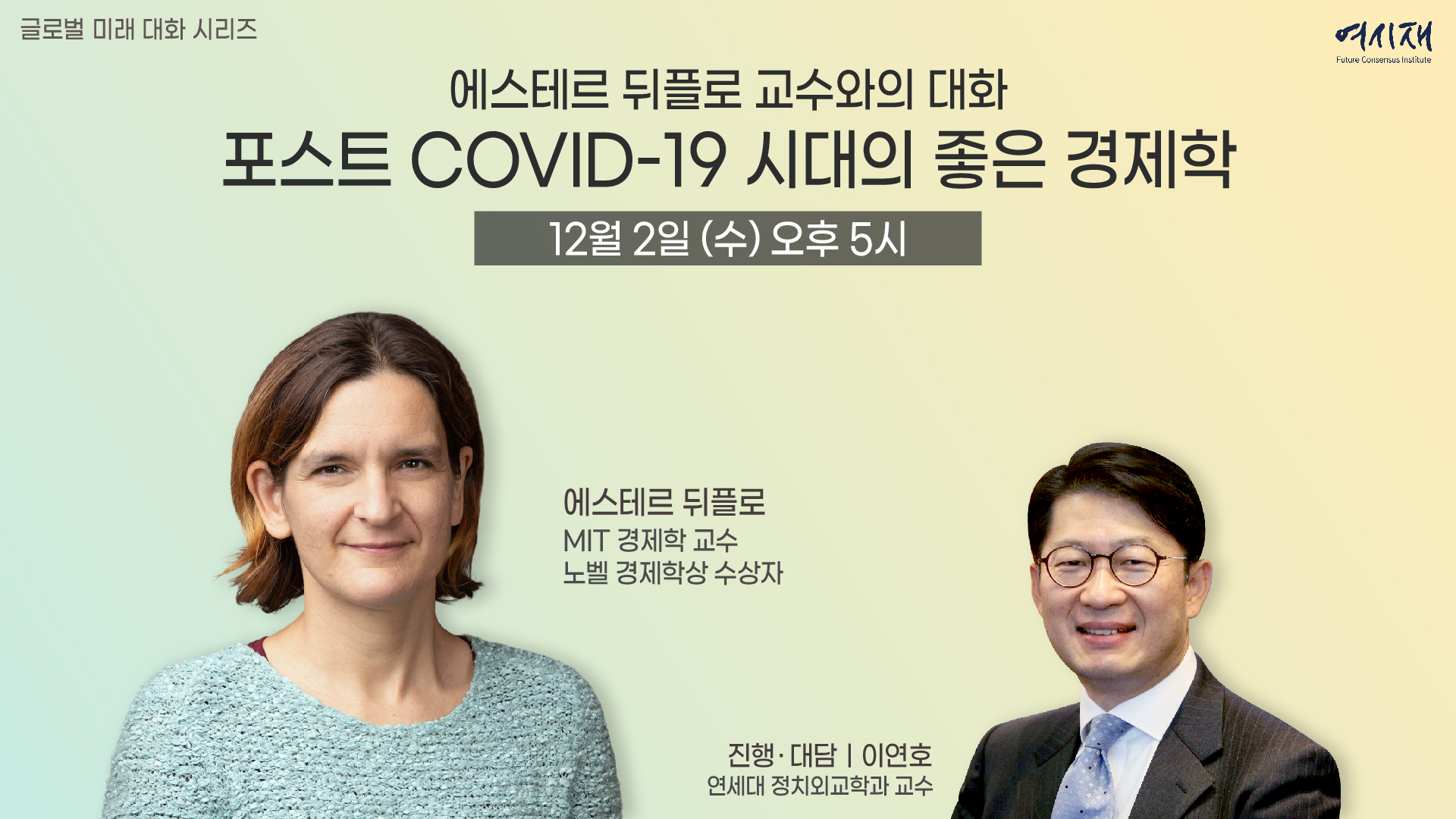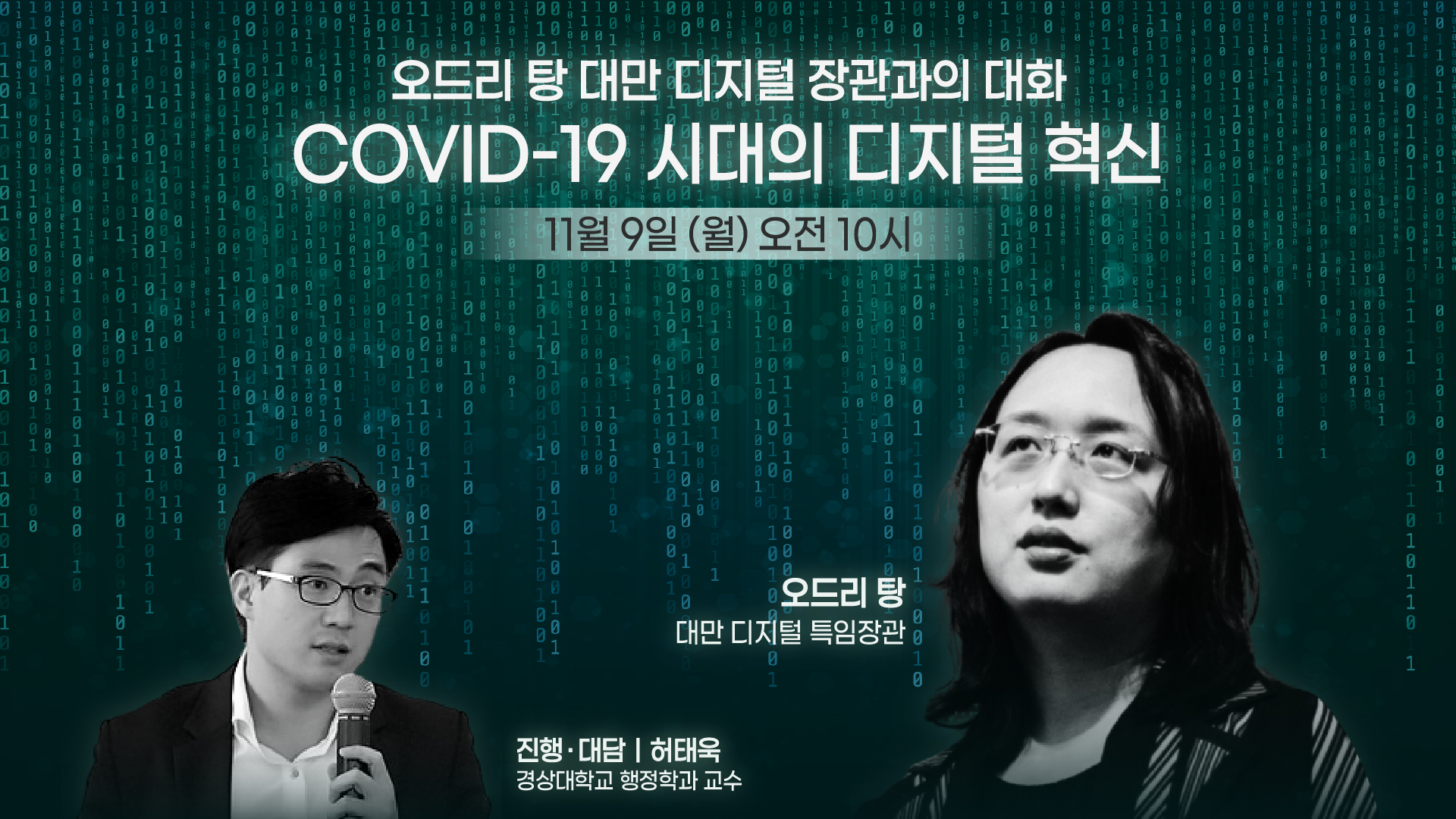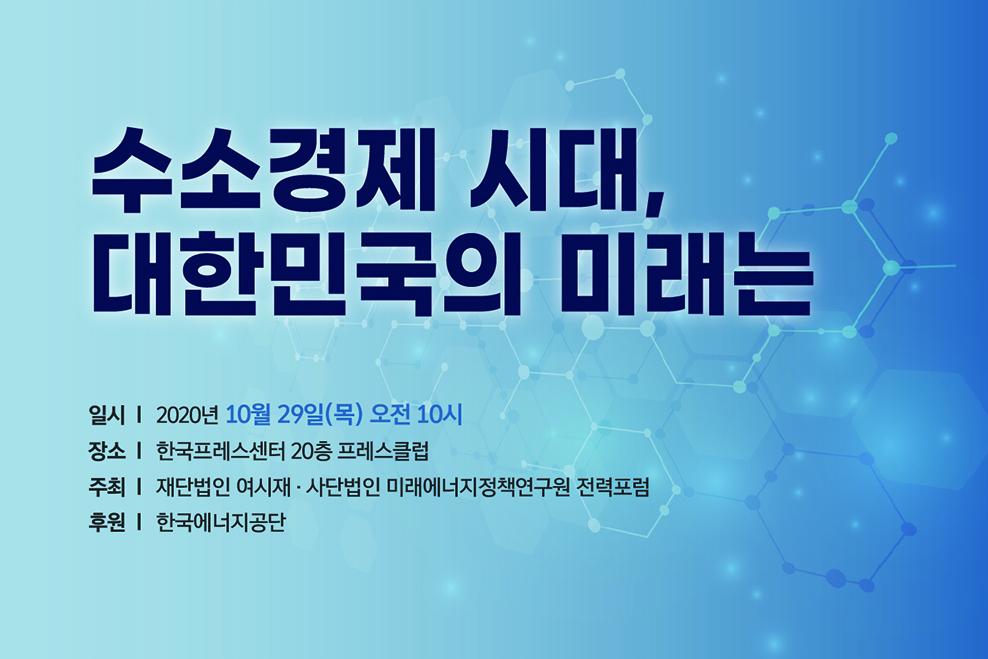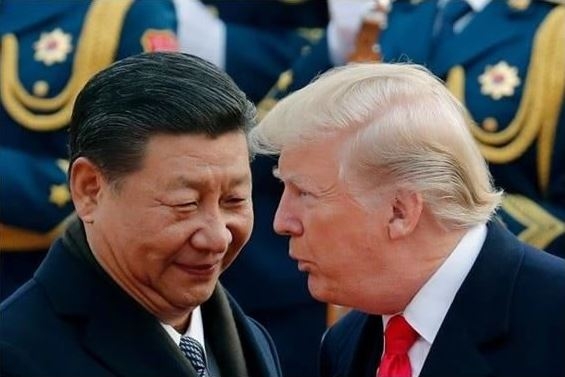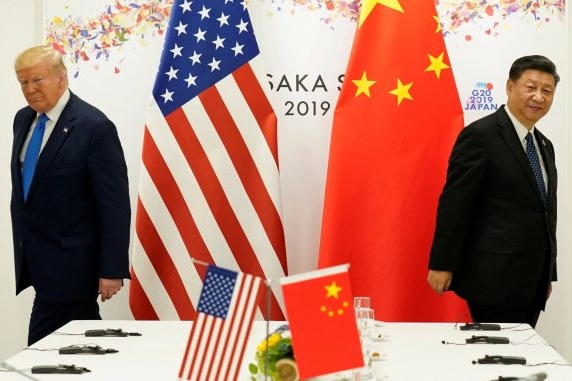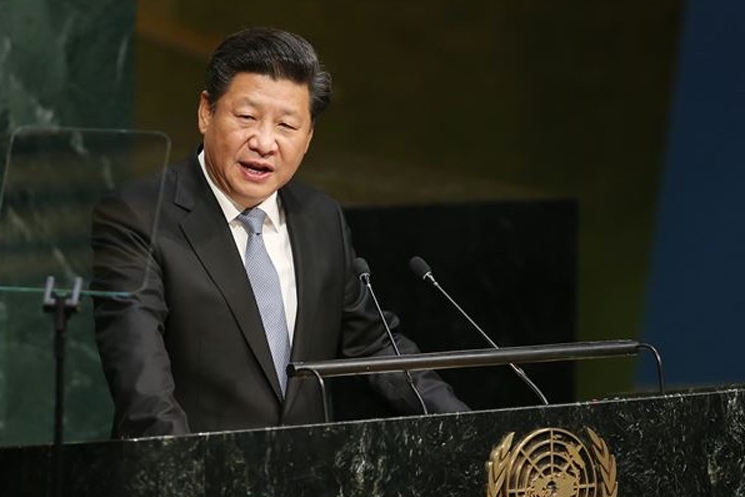Please join Yeosijae as we build a brighter future for Korea. Create your account to participate various events organized by Yeosijae.
- Insights
- |
- Global Order and Cooperation
[How Japan view China ②] Challenges facing the Chinese economy
|
One of the biggest concerns of modern Japan is ‘China.’ There have been numerous seminars, symposiums, and private learning sessions on the topics of “The Change of China” and “The Future of US-China Relations.” Korea, as well, pays attention to the issue of how Japanese academia and elite groups view China. Consequently, Yeosijae decided to introduce four papers from Japan’s Society of Security and Diplomatic Policy (SSDP) on such themes. The papers were originally published in the Research Journal of ‘Security Studies’. |
Osamu Tanaka
Chief Senior Researcher, Institute of Developing Economies, JETRO
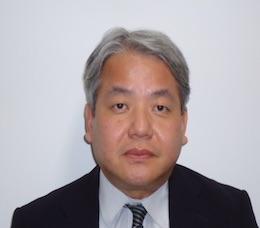
Introduction
This paper is intended to discuss how the structural imbalances of the Chinese economy have been improved to date and what new problems are emerging, as well as other issues including the reform of state enterprises; social security issues affected by a declining birthrate and an aging population, and new development strategies.
Space
1. Economic structure imbalance
(1) Imbalance between investment and consumption
Overheated investments have so far occurred periodically in China. Among the examples are an overheated investment that took place immediately after the “Southern Tour Lectures” (1992) by Deng Xiaoping, and one on the heels of the inauguration of the Hu Jintao Leadership in 2012.
The largest cause of repeated overheated investments is the fierce competition for development among local governments, which is closely related to races for promotion among local political leaders. China’s large-scale governmental personnel changes occur once every five years, and central and local executive personnel affairs are managed in an integrated fashion by the Organization Department of the Communist Party of China (CPC). For this reason, local government executives set a growth target exceeding the Beijing government’s growth rate goal; and by achieving the growth target, they aim to obtain a post in the central government or a promotion in the region that they govern. As a result, a large number of show-off projects are developed called “political achievement projects” and “image making projects,” and inefficient “blind random investments” are announced every time governmental personnel change.
In the past, consumption contributed little to China’s economic growth, because personal income growth was lower than economic growth. China’s growth strategy was to produce and export cheap products by capitalizing on low wages and to increase its share in the international market, thereby achieving economic growth. As a result the strategy has limited the expansion of consumption in China.
Furthermore, China’s large-scale economic measures in the period of November 2008 to 2010, which were launched in response to the Lehman shock of September 2008, featured an additional investment of 4 trillion yuan. They aimed at supporting the economy through governmental infrastructure investments and capital investments by state enterprises. As a result, the investment-consumption imbalance increased significantly during this period (Table 1).
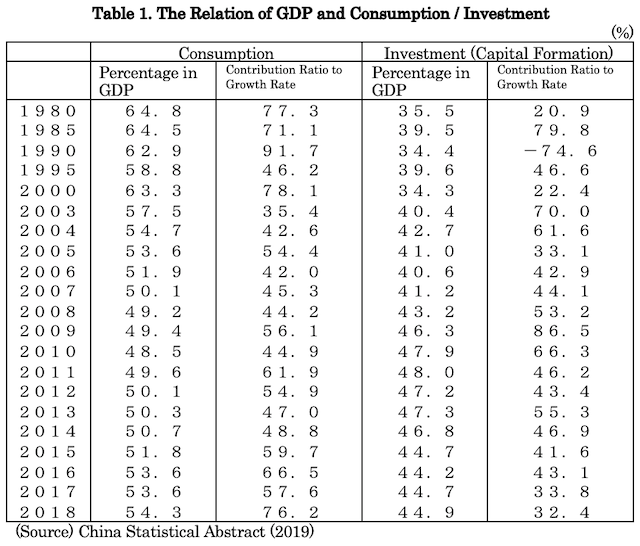
From 2012, however, consumption’s percentage in GDP constantly exceeded 50%, and since 2014, its contribution ratio to growth rate has continuously been higher than that of investment. Consumption has come to lead China’s economic growth.
This is largely because the Chinese government has urged a drastic increase in minimum wages since 2010, and has helped increase personal income and labor share. When it comes to service consumption, the spread and expansion of new services such as e-commerce and courier services may have stimulated consumption demand.
The next issue will be how to respond to the diversification and sophistication of consumption demand. At present, the quality of economic development (supply side) has not caught up with the diversified and sophisticated demands of the Chinese people. As a result, the Chinese people are attracted to “explosive shopping sprees” overseas. They attach importance to not only the quality but the “safety and security” of merchandise.
(2) Imbalance between the secondary and tertiary industries
From the Mao Zedong era, China’s industrial policy focused exclusively on heavy industry, with the US-China confrontation and the subsequent Sino-Soviet confrontation in the background. The trend remained unchanged even after the “Reform and Opening-up,” and the development of the tertiary industry in China was left largely behind. (Table 2).

In 2012, however, the weight of the tertiary industry surpassed that of the secondary industry, and its percentage in GDP exceeded 50% in 2015. In terms of contribution ratio to growth rate, the tertiary industry has surpassed the secondary industry since 2013, exceeding 50% in 2015. The tertiary industry has now led China’s economic growth.
Since there are many labor-intensive corporations in the tertiary industry, China’s ability to absorb employment for every one percent growth rate has increased. The reason why employment in China is relatively stable regardless of the current slowing economic growth is that new service industries like courier services absorb workers displaced from industries burdened with excess production capacity, such as the steel and coal industries.
On the other hand, when the economy shifts to the tertiary industry that has lower labor productivity than the secondary industry, the shift will reduce the productivity of the Chinese economy as a whole, and as a consequence, the potential growth rate will drop. If the Chinese economy is to maintain medium level growth over the long term, it will be imperative to improve productivity through innovation.
(3) Urban-rural disparities
Reforms in China initially evolved mainly in rural areas, and farmers’ incomes increased thanks to a series of reform efforts including the dismantlement of the people’s commune, the introduction of a production contract system, and the free sale of agricultural products. However, as industrialization and urbanization progressed, the urban-rural income disparities expanded from the latter half of the 1990’s, and after the turn of 21st century, the disparities more than tripled. (Table 3)
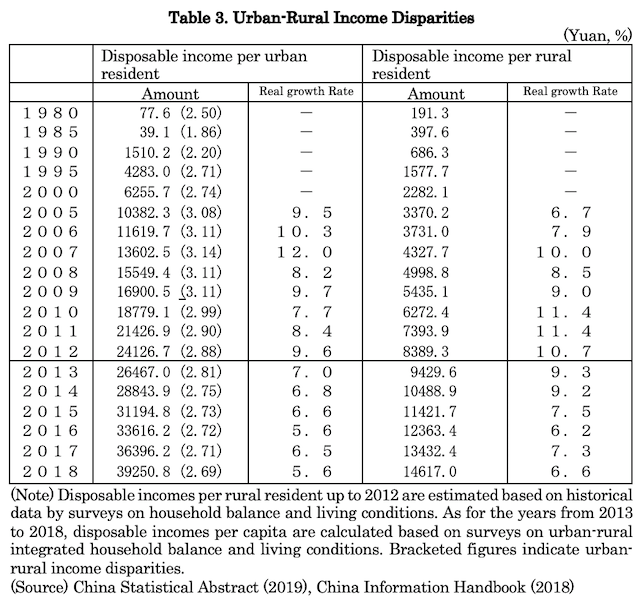
The widening of urban-rural income disparities developed as follows. Agricultural production in China started to increase from the latter half of the 1990’s. Ironically, good harvests caused a decline in the prices of agricultural products and some farmers suffered from sluggish income. In addition, local governments collected from farmers taxes and expenses under various names, further diminishing farmers’ disposable income. Moreover, farmers were initially excluded from social security because they possessed land. As a result, rural society became unstable, and group protests by farmers increased from around 2000. These protests grew in size year by year.
In response to this, the Hu Jintao leadership that was inaugurated in 2002 placed the solution of the “Three Rural Issues” (agriculture, rural areas and farmers) as the top priority of the CPC’s priority policies and worked to reduce the urban-rural gap by abolishing the agricultural tax and livestock tax; increasing agricultural subsidies; raising the purchase price of grains; lifting the minimum wage, and improving the social security system. As a consequence, since 2010, farmers’ income has grown faster than that of urban residents, and the average income disparities have gradually narrowed.
At present, the Chinese economy is undergoing a major period of transformation in the world economy, called the fourth industrial revolution. If China’s agriculture cannot cope with this transformation but remains at the conventional primary industry, the urban-rural economic gap may widen again. To respond to this, the Xi Jinping leadership is advancing the “modernization of agriculture and rural areas” and the “rural vitalization strategy.” If these policy measures can prove to be more than a slogan and score steady results, they will become the key to the stabilization of rural communities.
(4) Income disparities
While the average urban-rural income disparities are shrinking, income disparities continue to widen inside the urban or rural community, or between the urban upper class and the rural bottom class. (Table 4)
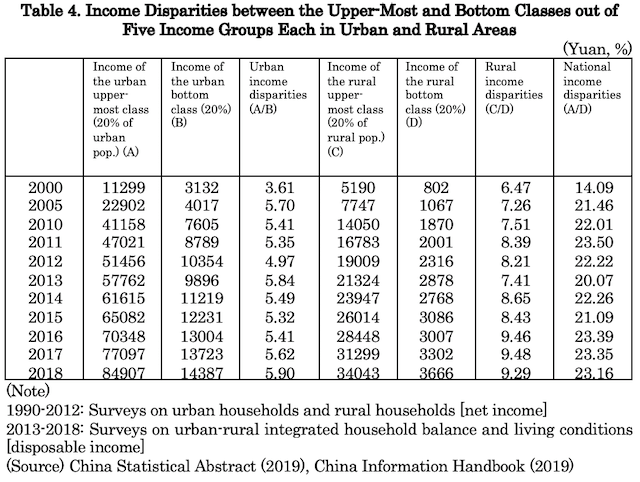
In China there used to be no inheritance tax or gift tax. Personal income was divided into 11 categories, and as many levels of tax rates were applied. Therefore, the income redistribution function of tax was limited. The Jiang Zemin leadership continued with the “Let-some-people-get-rich-first” policy regardless of the widening income gap.
The Hu Jintao leadership rectified this policy, and attempted to shift to the “common wealth” policy and to promote realization of the “harmonious society.” Yet its failure to establish a strong leadership within the CPC prevented the leadership from achieving anything more than curbing the widening of urban-rural gap. Huge “vested interest groups” were born during the Jiang Zemin era, groups which, as the resistance force, hindered the leadership’s reform efforts.
The 19th National Congress of the CPC stated that China would significantly reduce economic disparities by 2035, and achieve the “common wealth” in the middle of the 21st century. As one of the new three-step economic development strategies toward 2020, China has made it a goal to salvage 55 million of the poorest segment of the rural population, providing relief for as many as 10 million people every year. However, besides the problem of the 55 million poorest, there still exist a huge number of indigent people around the country. The incumbent leadership is facing another challenge of staving off the resistance of vested interest groups and of increasing the middle-income class population through the implementation of a bold income redistribution.
(5) Regional disparities
Abiding by the “Let-some-people-get-rich-first” policy, Deng Xiaoping prioritized the development of coastal areas that would be beneficial to trade. Even after the death of Deng Xiaoping, Jiang Zemin and Zhu Rongji, both of whom had their power base in Shanghai, basically pursued this line of policy. In contrast to the remarkable development of the eastern regions, the middle and western regions was left behind and economic disparities between them widened. (Table 5)

The Hu Jintao leadership had since its inauguration been implementing intensive public investments in the middle and western regions of the country. As for the large-scale economic measures in particular taken during the period of November 2008 to 2010, public investments were concentrated in the middle and western regions to develop a network of high-speed railways and highways. The result is that urbanization in the middle and western regions progressed, and Wuhan, Changsha, Zhengzhou, Chongqing, Chengdu, Xian, etc. grew into important urban centers. Nowadays, regional disparities in China tend to decrease.
What remains to be addressed is the development of Northeast China, which was mostly left behind in development. Since 2019, the new “north-south disparities” have been taken up as another problem. (See “2. State-owned enterprise reform in China.”)
2. State enterprise reform
(1) History of state enterprise reform
Overheated investments that occurred in 1993 and subsequent severe tightening of the economy exposed the deteriorated management of state enterprises from around 1996, and the strengthening of corporate governance of state enterprises emerged as a significant issue. In 1999, the fourth plenary session of the 15th CPC Central Committee debated the reform of state enterprises, and decided to take the following measures: 1) the separation of social functions (social security, housing, schools, hospitals, etc.) from state enterprises; 2) the sale of state-owned SMEs; 3) the introduction of a new management mechanism (shareholders’ meeting, board of directors, and board of auditors), and 4) the share-holding system and mixed ownership system for state enterprises. These measures promoted the conversion of large state enterprises into joint-stock companies and the privatization of state-owned SMEs.
At the 16th National Congress of the CPC in 2002, Jiang Zemin stated, “We must unswervingly consolidate and develop the public sector of the economy and also encourage, support and guide the development of the non-public sectors of the economy” in conformity with the basic economic system principle.
The 2004 constitutional amendment included provisions to the effect that the state should encourage and support the development of non-public economies such as individual and private economies, and that Chinese citizens’ legal private property is inviolable. Expectations became high for advancing reforms.
However, in the latter half of the same year, the leftist conservatives increasingly criticized the then on-going state-owned enterprise reform for draining state-owned assets, and reform efforts became stagnant. Furthermore, the large-scale economic measures implemented from November 2008 to 2010 encouraged state enterprises to make proactive capital investments, and funds for that purpose were concentrated to state enterprises. Thus, state enterprises were further enlarged. Some state enterprises bought out private enterprises, and the phenomenon of “the state enterprises advance, the private sectors retreat” began to invite public attention.
In 2011, however, as the effects of economic measures halted, state enterprises faced the serious problem of excess production capacity, and their management deteriorated rapidly. Although state enterprises grew in size, they also lost competitiveness by lowering the return on equity (ROE) and the return on assets (ROA).
In response to this, the third plenary session of the 18th CPC Central Committee in 2013 decided to accelerate the reform of state enterprises. Specifically, it decided to strengthen the supervision and management of state-owned assets mainly through capital management rather than business management. Furthermore, the committee also decided that part of state-owned capital should be divided and appropriated to increase social security funds.
These decisions seemed to immediately accelerate the reform of state enterprises, but when the enlargement of state enterprises was incorporated in the 13th Five-Year Plan (2016-20), the reform lost momentum and again stagnated. However, the 19th National Congress of the CPC in 2017 reconfirmed general guidelines to accelerate the optimized arrangement, structural adjustment, and strategic reorganization of the state-owned economy; promote the amelioration and aggrandizement of state-owned capital rather than state enterprises, and to advance the reform of state enterprises, thereby developing a mixed-ownership economy.
Thus, the reform of state enterprises is characterized by repeated advances and stagnation. This is probably because the CPC leadership is anxious that the ruling base of the CPC would weaken, if the state-owned economy regressed. They have not been freed from their dependency on the state-owned economy.
(2) North-south gap and the state enterprise reform
Nowadays it is a popular topic in Beijing that along with the Chinese economy’s transition from high growth to medium growth, the regional economic disparities have evolved from a gap among the eastern, middle, western regions, and Northeast China to a north-south gap. This fact was pointed out by Zhou Xiaobo and Chen Zuo of the School of Economics of Renmin University of China, and Wang Jiyuan of the Land Development and Regional Economy Research Institute, Macroeconomic Research Institute, National Development and Reform Commission.
According to the experts, the 2007-12 GDP growth rates of the northern and southern regions basically remained equal --- the north grew slightly faster than the south. However, in the period of 2013-17, the north-south growth rate gap increased from 0.41% in 2013 to 1.4% in 2017. The average annual economic growth rate in 2013-17 was 7.4% for the north, while 8.5% for the south.
Again, according to the above-mentioned experts, a cause of this north-south disparity can be accounted for by the fact that the state enterprises in the north engaged mainly in heavy industry, lagging behind in marketization reform and economic structural change / innovation. Meanwhile, private enterprises prospered in the south, promoting market economy / service economy and innovation.
In order to increase the potential growth rate of the Chinese economy as a whole, it will be necessary for the north to actively advance the reform of state enterprises and marketization reform, and provide support for private enterprises.
3. Social security
(1) Rapidly declining birth rate and fast aging
Unlike Japan, the Chinese economy’s high growth ended while the social security system was still being developed. On the other hand, the aging of Chinese society is rapid. As of 1990, the population over 65-years-old accounted for only 5.6% of the total population; whereas in 2000 it reached 7% (the advent of aging society), and in 2018 it reached 11.9%. China is expected to enter an aged society (the proportion of over-65 older people: 14%) around 2025, and a super-aged society (21%) by around 2038.
On the other hand, due to the long-lasting “one-child policy,” China’s 15- to 64-year-old population has been declining since its peak in 2013, which constitutes a factor in lowering China’s potential growth rate. Since 2016, China has implemented a “full-fledged two-child policy,” but the decline in the birthrate has not stopped.
In other words, China will enter an aged society before realizing “common wealth.” Therefore, the largest problem of the Chinese economy and society is said to be “getting aged before becoming rich.”
(2) Improvement of the pension system
The Chinese pension system has been developed on a full scale since the second half of 1990’s. As part of the state enterprise reform by Prime Minister Zhu Rongji, the social security system was separated from state enterprises. In 1997, the Basic Pension Insurance for Urban Employees (BPIUE) was established, and in 2011, the Social Pension Insurance for Urban Residents for urban registered unemployed workers. Meanwhile, the New Rural Social Pension Insurance was introduced in rural areas from 1992, but farmers could not receive state-subsidies for the reason that they possessed land. As late as 2009, they began to receive state-subsidies. In 2014, the Urban and Rural Residents Basic Pension Insurance (URRBPI) was established by integrating the Social Pension Insurance for Urban Residents and the New Rural Social Pension Insurance. Thus, the Chinese pension insurance system was consolidated into two types --- BPIUE and URRBPI.
Hereafter, the Chinese government will have to unify operations of the system that vary among provinces, and to integrate the two types of pension insurance system to establish a unified nationwide basic pension insurance system. However, in the three provinces of Northeast China, for example, the operational unification is not progressing due to the deficit of pension finance and the backlash from other provinces with abundant financial resources.
(3) The source of pension payments
If the current situation continues, in the second half of the 2020’s, people from the generation of the Cultural Revolution, relatively large in number, will reach the age for pension benefits, and pension finances will quickly deteriorate. On the other hand, the Xi Jinping leadership called for corporate cost cutting as part of the supply-side structural reform to lower social insurance premiums. In May 2019, the premium of the Basic Pension Insurance for Urban Employees was reduced from 20% to 16% in principle.
However, the impact of such reduction of social insurance premiums on the sustainability of pension finance has not been clarified. The Chinese government explains that part of the state enterprise stocks will be transferred to pension funds as the source of pension payments. But the government should explain to the people about long-term pension finance, and clarify the outlook for revenue and expenditure and their calculations to fill the shortage of financial resources by appropriating how much of which revenue --- tax, insurance premiums, or income from the sale of state enterprise stocks.
If China enters a super-aged society in the second half of the 2030’s, the costs of geriatric medical care and nursing care will increase significantly. It is of primary importance to immediately work on the relevant type of system to address questions such as: to what extent to cover those costs by public insurance; what cost to supplement by private insurance, and how to position the roles of family and community. The ultimate goal is the construction of a sustainable social security system.
4. China’s development strategy toward 2035
The 19th National Congress of the CPC stated that China must complete a modernized economic system by 2035. Xi Jinping elaborated the specific contents of the modernized economic system at the group study session of the Politburo of the CPC on January 30, 2018.
According to Xi’s speech at the study session, “The modern economic system is an organic whole consisting of the interrelationship and intra-relations of all links, levels and sectors of socio-economic activities.” He emphasized that the following seven systems must be “unified and integrated, and we must focus on the ‘Integrated Construction and Advancement.’”
(1) An innovation-driven industrial system with coordinated development
The system aims at a coordinated development of the real economy, scientific and technological innovation, modern finance, and human resources. To this end, the contribution of scientific and technological innovation to the development of the real economy should be improved, and the capacity of modern finance to serve the real economy should also be intensified. In addition, the role of human resources supporting the development of real economy should be optimized.
(2) A unified, open, competitive and orderly market system
The system aims at a market that is easy to enter, and open and orderly. Enough competition should be guaranteed there, and the market order standardized. To this end, it will be imperative to accelerate the formation of a modern market system where corporations are responsible for autonomous management and fair competition; consumers are guaranteed free choice and consumption, and merchandize and factors of production can flow freely and be exchanged equally.
(3) An income distribution system embodying efficiency, promoting equity
The system aims at a reasonable income distribution, thereby realizing a fair society with justice, where all the people can enjoy a common prosperity. To that end, it will be imperative to promote the equalization of basic public services and a step-by-step reduction of income distribution gap.
(4) An urban-rural regional development system demonstrating local advantages, coordination and linkage
The system aims at advantageous regional interactions; an integrated development of cities and rural areas, and the optimized unification of land and sea as a whole. To that end, it will be necessary to foster and exert local advantages; intensify mutual complementarity among regions, and create a new structure where regions can cooperate and develop concertedly.
(5) A resource-saving, environment-friendly green development system
The system aims at green development, recycling, low carbon, and harmonious coexistence between humans and nature. To that end, it will be necessary to establish and practice the concept that “green mountains and clear water are equal to mountains of gold and silver,” and to create a new framework for achieving modernization based on the harmonious development of humans and nature.
(6) A diversified, balanced, secure, efficient and comprehensive open system
It will be necessary to promote the Opening-up policy toward the development of a higher-level open economy, as well as a shift to structural optimization, deep level development, and efficiency improvement.
(7) An economic system giving full play to the role of the market and better playing the role of the government
Among the goals are: the market mechanism is effective; micro economic agents are active, and the macro control is moderate.
From the above, it is obvious that the Xi Jinping leadership is fully aware of economic systems essential to the sustainable development of the Chinese economy, and of policies to create the systems. However, what matters most is the ability to attempt things and to realize goals. The Hu Jintao leadership had ambitious goals at the outset, but could not realize them due to obstruction by the forces of resistance.
Conclusion
Finally, what path will the Chinese economy follow in the future? The current Chinese economy is facing a difficult situation, as evidenced by the declining potential growth rate and the economic downturn due to the increasing US-China trade friction.
The future of China is anything but predictable. If China has a national objective to realize its modernization by overcoming the “trap of middle income countries,” and to become a superpower comparable with the United States in the middle of the 21st century, the country will be required to at least fulfill, the following conditions:
- By leveraging from the current external pressure from the US-China economic friction, China should accelerate the reform of state enterprises, deregulation, and the improvement of market environment, and pursue more thorough market reform and the Opening-up.
- China should establish a sustainable social security system before people of the Cultural Revolution generation will reach the age for pension benefits in the late 2020’s.
- China should resolutely carry out the income distribution reform and the personal income tax reform; introduce real estate tax, inheritance tax, gift tax, and provide support to the low-income group, thereby creating a stable middle-income group.
- China should maintain a stable and peaceful cooperative relationship with the United States and East Asian countries by overcoming the 19th century nation-state view that China would not refrain from war to safeguard its national sovereignty and territorial integrity.
- China should change from a “feared country” to a “respectable country” by taking leadership in implementing lofty ideals regarding the future visions of international politics, economy, and global environment.
In order to meet these requirements, a strong leadership and insight will be required of the Chinese leader. Currently, Xi Jinping is concentrating power in his person, and seems to be meeting the necessary conditions. What matters most for him is how to use power. If Xi uses power to promote the Reform and Opening-up, China’s future will be hopeful. But if he abuses power and the Reform and Opening-up policies stagnate, the confrontation with the United States will enter a critical phase. Domestically, the dissatisfaction of the people will increase, and the end of the CPC administration may come sooner than expected.
In any case, in view of the speed of working population reduction and the aging of Chinese society, time at our disposal is not abundant. Japan should carefully observe the policy trends of the Xi Jinping administration in the second term, and, if necessary, offer proposals and cooperation proactively toward the Chinese leadership.
(References)
- Zhou Xiaobo, Chen Zuo, Wang Jiyuan, “The Current Status, Causes and Countermeasures of China’s North-South Economic Divide --- Noteworthy New Trends” (Hebei University of Economics and Trade, Volume 40, Issue 3, May 2019).
- Osamu Tanaka, “The Current Status and Challenges of China’s Economic Reform” (The February 2019 issue of the “Toa” journal published by Kazankai).
- Osamu Tanaka, “Forty Years of China’s Economic Reform --- Achievements and Problems” (The October 2019 issue of the “International Affairs” by The Japan Institute of International Affairs)
(This paper was translated into English by Tsutomu Inuzuka, SSDP Associate)
< Copyright holder © TAEJAE FUTURE CONSENSUS INSTITUTE, Not available for redistribution >

